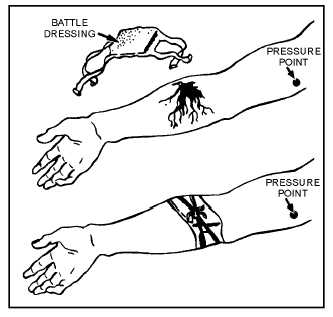1-12
(1) NEAREST THE WOUND and (2) BETWEEN THE WOUND AND THE MAIN PART OF
THE BODY.
Applying finger pressure is very tiring, and it can seldom be maintained for more than 15 minutes.
Pressure points are recommended for use while direct pressure is being applied to a serious wound. While
pressure is being applied at the appropriate pressure point, an assistant can bandage the wound (or
wounds). If available, a battle dressing should be used. Figure 1-7 shows the battle dressing and its use.
After opening the dressing, be careful not to contaminate it. Place the compress portion over the wound,
then bind it tightly in place with the attached straps. If bleeding continues to be severe even after direct
pressure and pressure points have been used, you may have to apply a tourniquet.
Figure 1-7.—Battle dressing.
Use of the Tourniquet.—A tourniquet is a constricting band that is used to cut off the supply of
blood to an injured limb. It cannot be used to control bleeding from the head, neck, or trunk, since its use
in these locations would result in greater injury or death. A tourniquet should be used only if the control
of hemorrhage by other means proves to be impossible.
Basically, a tourniquet consists of a pad, a band, and a device for tightening the band so that the
blood vessels will be compressed. There are several different kinds of ready-made tourniquets. A variety
of materials can be used to improvise tourniquets. Any round, smooth pressure object may be used for the
pad — a compress, a roller bandage, a stone, a rifle shell — and any long, flat material may be used as the
band. However, the band must be flat: belts, stockings, flat strips of rubber, or neckerchiefs can be used;
but rope, wire, string, or very narrow pieces of cloth should not be used because they will cut into the
flesh. A short stick may be used to twist the band, thus tightening the tourniquet.
A tourniquet must always be applied above the wound — that is, toward the body — and it must be
applied as close to the wound as practicable.
The best object to be used for the pad is either a bandage, a compress, or some similar pressure
object. The pad goes under the band. It must be placed directly over the artery, or it will actually decrease
the pressure on the artery and thus allow greater flow of blood. If a tourniquet placed over a pressure
object does not stop the bleeding, the pressure object is probably in the wrong place. If this occurs, shift



